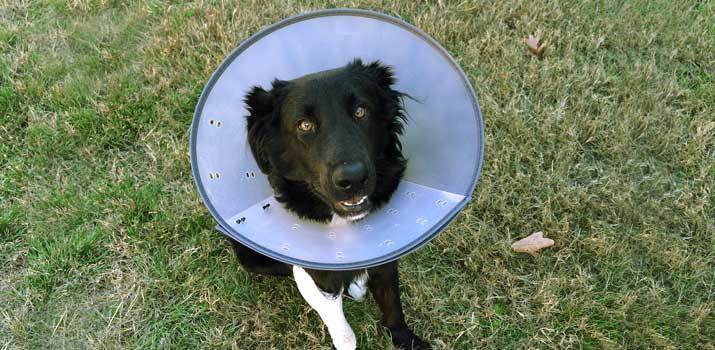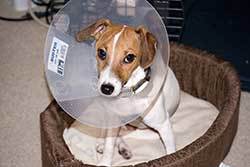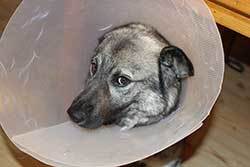Neutering is an essential part of modern dog ownership. Unless you plan on breeding your pup, it's recommended that you complete this procedure as soon as your dog reaches the appropriate age. Neutering can help control the pet population while also avoiding potential health issues in the future.
It can also help remove aggressive behavior and make temptations from the opposite sex a thing of the past!
The procedure, while necessary, isn't exactly the most pleasant experience for your canine companion.

It's a major surgery that requires anesthesia, stitches, and time to heal. Of course, Fido doesn't know what's going on. It can be a confusing time for your pooch. There are a lot of things that could go wrong as they heal.
As an owner, it's your responsibility to stay on top of your dog's recovery and make sure that those wounds heal up nicely.
What does dog neutering aftercare entail? How long does it take for dogs to get back to normal? When to take the cone off your dog?
If you've never cared for a dog after surgery, it can be a daunting task to prepare for. Luckily, we have you covered. Here's some useful information that can help your furry friend's post-surgery healing go off without a hitch.
The First 24 Hours After Neutering
The first 24 hours after surgery are often the most confusing. Not just for you, but also for your pooch. Chances are, your dog will be incredibly disoriented from the procedure when you take them home. Most vets also give canines long-term pain medications to keep pets calm and pain-free.
In terms of behavior, you won't even recognize your dog! Even the most active pup will be lethargic and confused. Once they start to get more aware, they may exhibit signs of depression. This is completely normal and should be expected.
The key to keeping your dog safe during this time is to just give them the opportunity to relax. You wouldn't want to be exposed to loud noises after coming out of surgery, so treat your dog to that same respect.
Create a comfortable spot for them to sleep. Give them a comfortable bed to sleep on. The room you keep them in should be dimly lit and comfortable.
If you have other pets or curious children running around, consider putting your dog in a separate room where they can get some rest without any bothers.
Should You Place Them in a Crate?
This depends entirely on your dog's demeanor. Sometimes, dogs will do just fine during that first day laying down on a bed near you. However, others will start to show signs of aggression once those pain medications start to wear off.
Aggressive behavior puts both you and your dog at risk. Regardless of your pup's relationship with you or anyone else in the home, the pain and confusion they are feeling could cause them to lash out. In this case, crating may be necessary.
Additionally, aggression may lead to your dog accidentally harming themselves. The stitches that dogs receive after neutering are very sensitive. They need plenty of time to heal. Sudden movements could easily damage those stitches, which will require repair to avoid infection.
If you do plan on using a crate, just make sure to line it with a comfortable bed. Don't treat it like a prison. Instead, treat it like a recovery space.
Food, Drink, and Medication
Getting your dog to eat or drink can be a bit tricky during that first day after surgery. The medication and anesthesia can ruin their appetite. It's important that you provide control accessed to the essentials for the first 24 hours.

Limit the food to just half of what you'd normally provide. You may also want to consider switching to canned food for their first meal to entice them and kickstart their appetite.
Just make sure to consult with your vet beforehand to get the go-ahead.
When it comes to water, try to keep things minimal. While hydration is crucial for your recovering canine, too much water may result in vomiting. It's important to be patient when it comes to food and water during the first day(s) back at home.
If your dog doesn't want to eat, don't force it. The last thing you want to do is cause stomach upsets during this delicate time.
Some vets prescribe pain medications to help with recovery. In most cases, these medications should not be given to your dog during the first 24 hours. Remember, the drugs given to them during the procedure may still be in their system.
These drugs should be reserved for the following days when your dog starts to feel the pain from the incision site. As always, follow the directions from your vet.
How Long Will My Dog Be In Pain After Neutering?
Generally speaking, serious pain lasts for two or three days after the surgery. With that said, several factors can contribute to pain levels. Some dogs handle the discomfort of recovery differently than others.
Of course, there's no way for dogs to tell us how they're feeling, so you'll need to keep a watchful eye on their behavior to get a better gauge on pain levels.
When Will My Dog Start Behaving Normally?
After about three days, you should notice that your dog's behavior is returning to normal. This is a great sign! However, it does not mean that you can just let your dog run free as if nothing happened.
Surgical wounds can take up to 14 days to fully heal! You need to continue watching your pup and restricting activity until you have met with your vet for a follow-up appointment.
If your dog is still showing signs of pain or lethargy after the three-day mark, visit your vet as soon as possible. The same goes for eating issues, a lack of appetite, and blood in their urine or stool.
Does My Dog Need to Wear a Cone After Neutering?
Your dog will hate it, but your dog must use a collar as they recover from surgery. An Elizabethan collar, commonly referred to as an E-collar, is specially designed to prevent accidental injuries.
They're typically made of plastic and are sized to extend passed your dog's snout. You can also find collars made out of foam or soft padding.
Whatever the case may be, that cone can make all the difference in the recovery phase.
There's a good chance that your dog will try to lick, scratch, and bite their wound. This could rip the stitches out and expose your dog to infection!
Cone help to create a barrier around their heads to keep this from happening. Most devices attach to their standard collar for convenience.
How Long Does a Male Dog Have to Wear the Cone After Neutering?
One of the biggest mistakes that dog owners will make when they're trying to help their pup recover from surgery is removing the cone too soon. It's easy to give in to those puppy-dog eyes.
Make no mistake; dogs will often exhibit all kinds of behavior to induce guilt so that you take the cone off. Stay strong and vigilant!

Cones should be worn for 10 to 14 days after the surgery. Remember, it can take up to two weeks for wounds to heal.
In most instances, vets will recommend that your dog wears the cone until they come in to get the stitches removed.
It's crucial that you follow those orders. If you've ever had to recover from surgery yourself, you know that wounds can get very itchy as they start to heal.
After about a week, that itching sensation will drive your dog nuts. During this time, having that cone on to prevent them from messing with the wound is paramount.
Can My Dog Sleep With a Cone On?
Your dog should have no problem getting a good night of sleep with the collar on. It might be a challenge at first. However, cones are designed to be as flexible as possible. The material used isn't so hard that your dog can't get around.
They'll still be able to lie down, walk around, and eat. Wearing the cone at night is especially important, as you won't be awake to stop them from messing with the wound.
Tips for Making Your Pup Comfortable with a Cone
Adapting to the dreaded cone is no easy task. This is particularly true if your pup is young. Expect to encounter some resistance from your furry friend.
Dogs will whine, bark, and cry to express their disdain for the cone. Some skilled escape artists will also do all they can to remove the cone themselves.
There are some things you can do to make things easier for them. While they won't alleviate the discomfort your dog feels with the cone on completely, it can make navigating the world a bit simpler.
Guide Your Dog
While your dog can still see with the cone on, their peripheral vision is affected quite a bit. Thus, your pooch will be bumping into furniture, walls, and even people. If you have a home with stairs, this lack of vision can be dangerous.
Guide your dog to help them get around safely. Use a leash anytime you go outside and use the sound of your voice to guide them in the right direction.
Teach Them How to Walk Properly
Another issue your pup will encounter is walking. Dogs usually walk with their snouts pointed downward. This results in the cone bumping into the ground with every step.
You can train your dog to walk with their heads held high. Not only will this avoid bumping and scraping, but it can improve their field of vision a bit.
Prepare Their Food and Water Bowls for Easy Access
Eating with a cone on can be a bit of a challenge but it's doable. Because the cone often extends past the snout, you must arrange the bowls strategically to give them access. Lift the bowls off the ground a few inches to ensure that the cone can get around them completely.
Only Take the Cone Off Sparingly
There are some instances in which you may take the cone off. However, this should be done sparingly and under strict supervision.
Many owners choose to remove the cone during meal times. It's not uncommon for pups to refuse meals with the cone on. Think of it as a sign of peaceful protest.
While we don't normally encourage appeasing that type of behavior, recovering after neutering is an exception. You can remove the cone to let your dog eat. However, you must be in the same room and have a direct line of sight at all times.
You should be close enough to stop them from scratching or biting the wound.
Be Thoughtful
Last, but not least, be a thoughtful dog owner! Is your pup having trouble getting in and out of the car or climbing stairs with the cone on? Lift them up and make their life a bit easier.
Your dog is only going to have these issues for two weeks, so you might as well just take care of any problems they're having. This results in less stress, more peace, and an overall better recovery process.
FAQs:
- Can My Dog Go for Walks During Recovery?
You can take your dog on short walks as they recover from the neutering procedure. But, you need to limit their activity as much as possible. All it takes is one wrong move to rip the stitch.
Your dog should be confined most of the time. If you're not home, keep them in a small room or crate so that they can't run around the home and injure themselves.
Walks should be short and playtime should be light. Don't let your dog interact with active dogs that will get him riled up. If your dog likes to jump on furniture, keep a watchful eye and create some barriers to prevent them from jumping.
- Observe Your Dog Regularly
During those two weeks of recovery, there's a lot of things to consider. You must be proactive about your dog's care and modify every aspect of their lifestyle to prevent any issues from occurring. Another thing you should be doing is observing your pup.
Keep an eye out on their behavior and check the wound twice a day. It's a good idea to teach your dog to roll over and expose his belly. This allows you to get a closer look at the incision site and check for damage.
Swelling and redness after neutering dogs are pretty common. Look out for discharge, bleeding, and excessive bruising. If any problems do occur, you can catch them early on and provide your dog with the care that he needs.
- Can I Keep my Dog from Licking Stitches Without a Cone?
Dogs instinctively lick their wounds, so keeping your pet from reaching their wound is an important part of surgery aftercare. Try covering the wound with soft fabric or use an alternative to the “cone of shame”
You can try an inflatable collar, soft E-collar or a neck brace collar.
Conclusion
Neutering your male dog can set him up for a healthy and happy life ahead. While the recovery process is never fun, it's well worth the outcome. With a bit of patience, careful observation, and a trusty cone in your arsenal, your pup will be back to his normal self in no time.
Also Read: My Dog Has Diarrhea But Acts Fine

